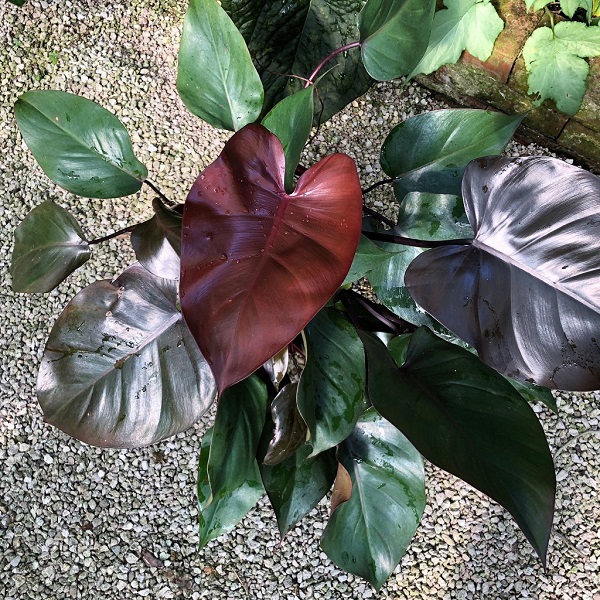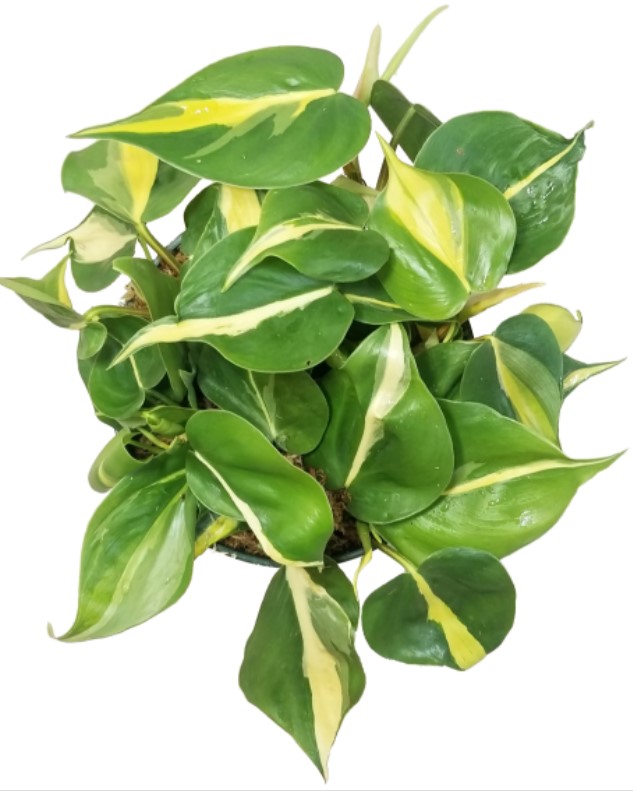This is a common question among those looking into ways to take care of, style, and propagate their indoor plants. The short answer is YES, philodendron can absolutely grow in water.
But how, and why does this matter? Let’s start with a little background on this beloved plant and get an understanding for why it is such a household standard.
Get To Know Your Love Tree
Philodendrons are one of the most beloved and commonly owned houseplants and for good reason – Easy, affordable, commonly available, air purifying, and adaptable, it makes sense that the name philodendron comes from the Greek words Philo (love) and dendron (tree).
There are many varieties of philodendron (over 400!). There are upright types and climbing varieties. The climbing or vining types in particular are very common, and they don’t mind being cut back as needed. These plants are very adaptable and low maintenance.

This is a plant that wants to be in a home environment. It will thrive in a temperate house setting without any fuss, so long as the plant parent follows a few simple rules.
Some joke that it is easier to keep a philodendron alive than it is to kill it – this plant wants to be your roommate and will do its part without much intervention needed.
Propagation Nation
To answer the question at hand, yes, you can root philodendrons in water, adding to their adaptability. Using a glass jar or vase filled halfway with chlorine-free water, add just the roots of the philodendron and keep the leaves above water level. If the clipping does not have roots, that’s ok too, they’ll develop in the water.
Pro Tip: You can achieve chlorine-free water by simply leaving tap water out overnight to allow any gasses to evaporate.
Adding cuttings from an existing plant to water is called propagating. It’s easy to grow more of many common types of houseplants using this method – take a healthy cutting, place it in water, allow roots to grow, and after roots have clearly developed, repot in soil. This process typically takes about 4 weeks given the right conditions.
This process not only allows you to create more plants for minimal cost, but it is an easy way to add the amount of plant life around your home for very little effort.
It can also be a way to shape the plant to your setting. Some want their plants to have a fuller look, others want a long and vining look, and some want their plants to grow vertically.
The philodendron is a plant that does not generally mind being styled as needed. Consider adding your cuttings back into the soil in a new position to make your plant appear fuller or consider adding a stick and binding portions of your plant to it with twine in order to encourage vertical growth.
Propagating your plant is a great way to give a thoughtful gift to a friend. The costs are almost nil, and you’ll be sharing a piece of your own home with the lucky recipient. It’s a wonderful and low-budget way to give something you love to someone special.
You don’t have to add the cuttings to the soil if that’s not your style. If you’d prefer to skip the mess of soil, you can keep your plant in water pretty much indefinitely.
Try a clear glass vessel so that you can see the roots in the water and keep an eye on how your philodendron is doing. This can be a very attractive way to house your plant and up the style factor in your home.
Philodendron’s Distinctive Traits
There are many different kinds of philodendron. The philodendron plant is commonly known for its distinctive heart-shaped leathery dark green leaves with rust-colored undertones.

The leaves can be veiny with touches of red or white and are usually glossy in texture. Sometimes the leaves are an all-over rust color.
With its origins in the tropics, the look of this plant adds a lush and slightly tropical look to any space. There are many varieties of philodendron, so it depends on what type you choose, but many can grow to large, luxurious sizes.
Can Philodendron Grow in Sun or Shade?
Philodendron thrives in partial sunlight, which is just one more way in which way the plant is not too fussy. They can be in the shadiest part of a sunny room or the sunniest part of a shady room and find a way to do well in either space.
Just make sure to keep them away from drafty parts of the house; they do like a consistent environment. As opposed to some other plants that don’t do well when they are relocated, philodendrons don’t mind trying out different spots around your house. See where they seem happiest and don’t hesitate to relocate as needed.
How Often Should I Water My Philodendron?
Just as you need to stay hydrated, your plants do too. You don’t need to be overzealous with watering. In fact, philodendrons have been known to thrive when nearly forgotten about, but the best-case scenario is that you keep your plant in slightly moist, well-drained soil.
Consider watering every 7 to 14 days and keep an eye on how well your plant does. Water until you see the liquid coming out of the drainage holes and allow any excess to catch in a basin or sink if possible.
A pot with drainage is the best way to ensure that the plant doesn’t develop ‘wet feet,’ an old-fashioned term for a plant with water pooled at the base.
A catch tray under any plant is a good idea to keep from making a mess in your home. Consider placing all of your plants in a shallow bath from time to time to allow them to absorb as much water as they may need. Think of it as a plant ‘spa day.’
Don’t worry if you miss a watering session. In fact, allowing the soil to dry out occasionally prevents the plant from developing root rot. In general, philodendrons are a hearty-plant that can withstand being ignored now and then.
Additionally, philodendron plants enjoy being misted from time to time. An added benefit is that the misting makes the glossy leaves even more attractive. Taking the time to lightly wipe them down after misting will also remove additional dust from the home environment.
Benefits of Philodendron
Having plants in the home is intrinsically tied in with wellness. The satisfaction you can draw from taking care of something outside of yourself. The feeling of accomplishment at helping a living thing flourish.
Heck, they can even be something to talk to. Plants have been known to be helpful to improve their owner’s mental health and are generally connected with wellbeing.
Beyond the mental health benefits, having plants around can benefit your physical health. Philodendrons in particular are known for their ability to trap dust particles. Their large leaves actually absorb toxins in the air. Airborne dust particles land on the waxy leaves and then can easily be wiped away, making the home easier to clean.
The plant’s large leaves have tiny pores on them that serve as mini air purifiers – they draw in the carbon dioxide we exhale and in turn put out fresh oxygen.

Photo by Skylar Kang
All plants do this as they photosynthesize, but the large dark green leaves of the philodendron are particularly efficient at expediting this task. The more plants you have in the home, the greater the air-purifying benefits you will reap.
By lightly misting the leaves of the plant from time to time, you’ll be adding to the humidity of the air. This can keep your skin and throat from reacting to irritating dry conditions, which is particularly helpful during the long winter months or if you live in an arid region. You may also start to feel like your home is a tropical oasis.
Life’s Better With a Philodendron
From air purifying to greening up your space, this plant is a giver on all fronts. The ability to grow this plant in either water or soil just adds to its flexibility in the home.
Having a comfortable and safe home environment has proven more important than ever in recent years, so adding a philodendron to your space is a safe bet when you want to green your space. This is a roommate you won’t need to background check and who does their part to contribute to a comfortable, clean and highly livable home environment.
Finally, a word of caution if you are a pet owner. As great as this plant is, it’s known to be toxic to animals when ingested (as are many other plants). If you have this plant around pets, make sure it’s in a location that is completely unreachable by the animals.
